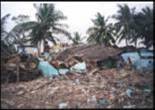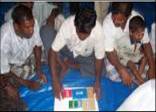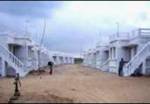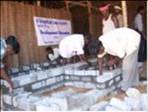|
Sustainable Reconstruction Initiative in Tsunami-affected Villages of Karaikal, Pondicherry, India Introduction The Tsunami, which struck the eastern coast of India on December 26, 2004, caused immense damage to life and property in the coastal areas of southern India. About 2.5 million people were affected, with over 150,000 houses destroyed or damaged and about 12,000 people died. Various government and non-government agencies have taken up the reconstruction of permanent shelters and rehabilitation of livelihoods. Development Alternatives, supported by the Swiss Red Cross under a Memorandum of Understanding with the Government of Pondicherry, undertook the initiative to reconstruct permanent houses in three villages of Karaikal region, in Pondicherry.The Project
Project Objectives
Response to Priority Needs The project responded to the identified priority needs of families in the affected villages: l Redevelop the village settlements with community facilities and infrastructure.l Reconstruct houses with basic amenities. l Generate economic opportunities and incomesl Impart knowledge and skills regarding safe and sustainable building construction practices.
Achievements The project was initiated in June 2005. In the past 22 months, the project has made significant progress towards its objectives: l Three new village settlements have been designed, keeping in view the local, cultural, and social needs as expressed in participatory design exercises, climatic considerations and safety features. The village layouts incorporate roads, drains, rainwater harvesting systems, landscaping features, etc.
l In addition, community facilities such as schools, childcare centres, and community halls are being designed and will be implemented unless these are constructed directly by any government agency. l At present, construction is in full swing in all the three new settlements. The handing over of one village settlement is due in October 2007, while the remainder two are planned for December 2007 and January 2008. l In addition, the project has trained over 70 artisans of the local contractors in safe and sustainable construction techniques and supported the set up of five enterprises producing fly-ash blocks, one of which is comprised of a women’s group from the villages. l The local building centre has been supported to build its capacities regarding safe construction practices and production of fly-ash blocks. This centre is now geared up to provide training to future entrepreneurs and artisans. l The project has initiated activities regarding greening the new settlements, eco-friendly ways of village street construction as well as capacity building of families in health and hygiene issues. l The project has also developed active bonds with various village groups the women, youth, disabled and the school children, in addition to the three Village Reconstruction Committees and the Panchayats it has worked with. The project has engaged the village stakeholders in order to develop designs, select contractors, offer supportive quality monitoring, create livelihoods, and develop the landscape and playgrounds in the new settlements. Priorities Now
The project would like to leverage its strong bonds with the village community and support the community to initiate and carry forth the activities to manage the new settlements. q Zeenat Niazi zniazi@devalt.org
|
 This
initiative, Sustainable Reconstruction Initiative in Tsunami affected
villages of Karaikal, Pondicherry, India, was designed to provide an
appropriate response to the reconstruction and rehabilitation needs of
1175 families in three villages of Karaikal region, Pondicherry in south
of India - Karaikalmedu, Kottucherrymedu and Kilinjalmedu. All three
villages were severely affected due to the impact of the tidal waves,
and the government had decided to relocate and provide them safe
habitation to mitigate future vulnerability. All of the totally 1175
families in the three villages had to be resettled in new houses under
the government guideline to relocate all habitation outside the Coastal
Regulation Zone 500m from the coast.
This
initiative, Sustainable Reconstruction Initiative in Tsunami affected
villages of Karaikal, Pondicherry, India, was designed to provide an
appropriate response to the reconstruction and rehabilitation needs of
1175 families in three villages of Karaikal region, Pondicherry in south
of India - Karaikalmedu, Kottucherrymedu and Kilinjalmedu. All three
villages were severely affected due to the impact of the tidal waves,
and the government had decided to relocate and provide them safe
habitation to mitigate future vulnerability. All of the totally 1175
families in the three villages had to be resettled in new houses under
the government guideline to relocate all habitation outside the Coastal
Regulation Zone 500m from the coast. The
overall objective of the project was reconstructing houses with basic
amenities and provide community infrastructure and facilities in the
three villages in Karaikal region of Pondicherry in an environmentally,
socially and economically sustainable manner. The project was aimed to
rebuild/reconstruct, improve the (physical) habitat condition, community
infrastructure and income levels of all families in the concerned
villages. While the project has fulfilled the need for reconstruction of
houses in these villages, in the process it is also trying to
effectively utilize the opportunity to improve the quality of the built
environment, improve the living conditions especially with regard to
water and sanitation (health), introduce new livelihood opportunities,
and further enhance local capacities in order to trigger a positive
cycle of sustainable growth and development.
The
overall objective of the project was reconstructing houses with basic
amenities and provide community infrastructure and facilities in the
three villages in Karaikal region of Pondicherry in an environmentally,
socially and economically sustainable manner. The project was aimed to
rebuild/reconstruct, improve the (physical) habitat condition, community
infrastructure and income levels of all families in the concerned
villages. While the project has fulfilled the need for reconstruction of
houses in these villages, in the process it is also trying to
effectively utilize the opportunity to improve the quality of the built
environment, improve the living conditions especially with regard to
water and sanitation (health), introduce new livelihood opportunities,
and further enhance local capacities in order to trigger a positive
cycle of sustainable growth and development. The
effective response to these needs was based on creating awareness about
"environmentally social and economical sustainable building materials
and construction systems" and introducing the same in the
implementation, participation of the village communities in defining
their shelter design and construction technologies, introduction of
diverse economic opportunities, and capacity building of artisans and
builders in safe and sustainable construction practices.
The
effective response to these needs was based on creating awareness about
"environmentally social and economical sustainable building materials
and construction systems" and introducing the same in the
implementation, participation of the village communities in defining
their shelter design and construction technologies, introduction of
diverse economic opportunities, and capacity building of artisans and
builders in safe and sustainable construction practices. l
House designs have been developed in response to people’s needs and
cultural requirements as expressed in the design meetings with the
families. These house designs have incorporated structural safety
features to make them resistant to future natural disasters.
Environmentally sound construction materials and technologies such as
fly ash based bricks and rat-trap technique of construction have been
used.
l
House designs have been developed in response to people’s needs and
cultural requirements as expressed in the design meetings with the
families. These house designs have incorporated structural safety
features to make them resistant to future natural disasters.
Environmentally sound construction materials and technologies such as
fly ash based bricks and rat-trap technique of construction have been
used. An
entire range of community capacity building issues still remain, which
include the use and management of toilets, that are a new phenomenon;
solid waste management in the new settlements; maintenance of public
assets; and landscape development. In order to fill up these gaps, the
project is aiming at a second phase of intensive community development
activities.
An
entire range of community capacity building issues still remain, which
include the use and management of toilets, that are a new phenomenon;
solid waste management in the new settlements; maintenance of public
assets; and landscape development. In order to fill up these gaps, the
project is aiming at a second phase of intensive community development
activities.